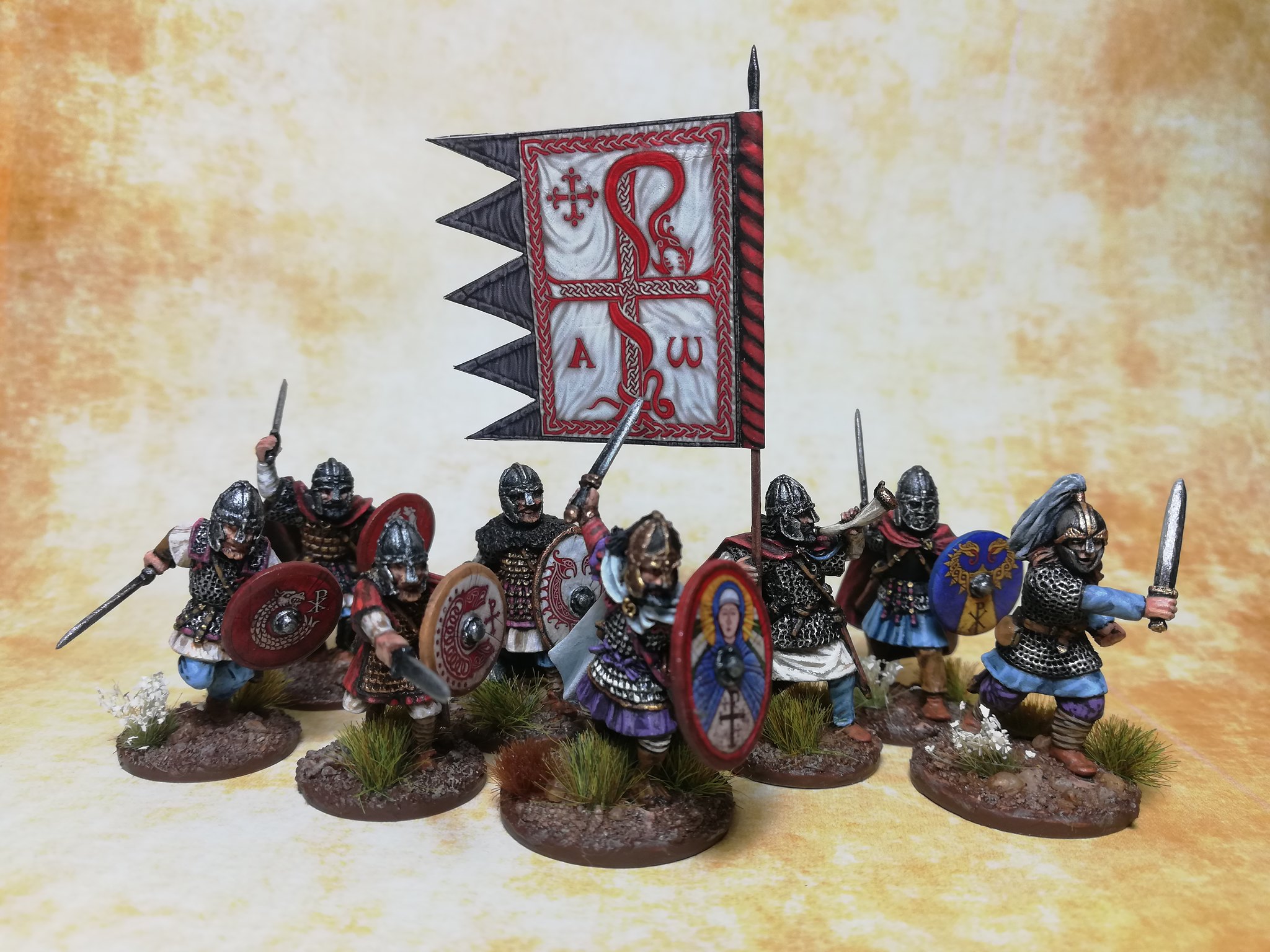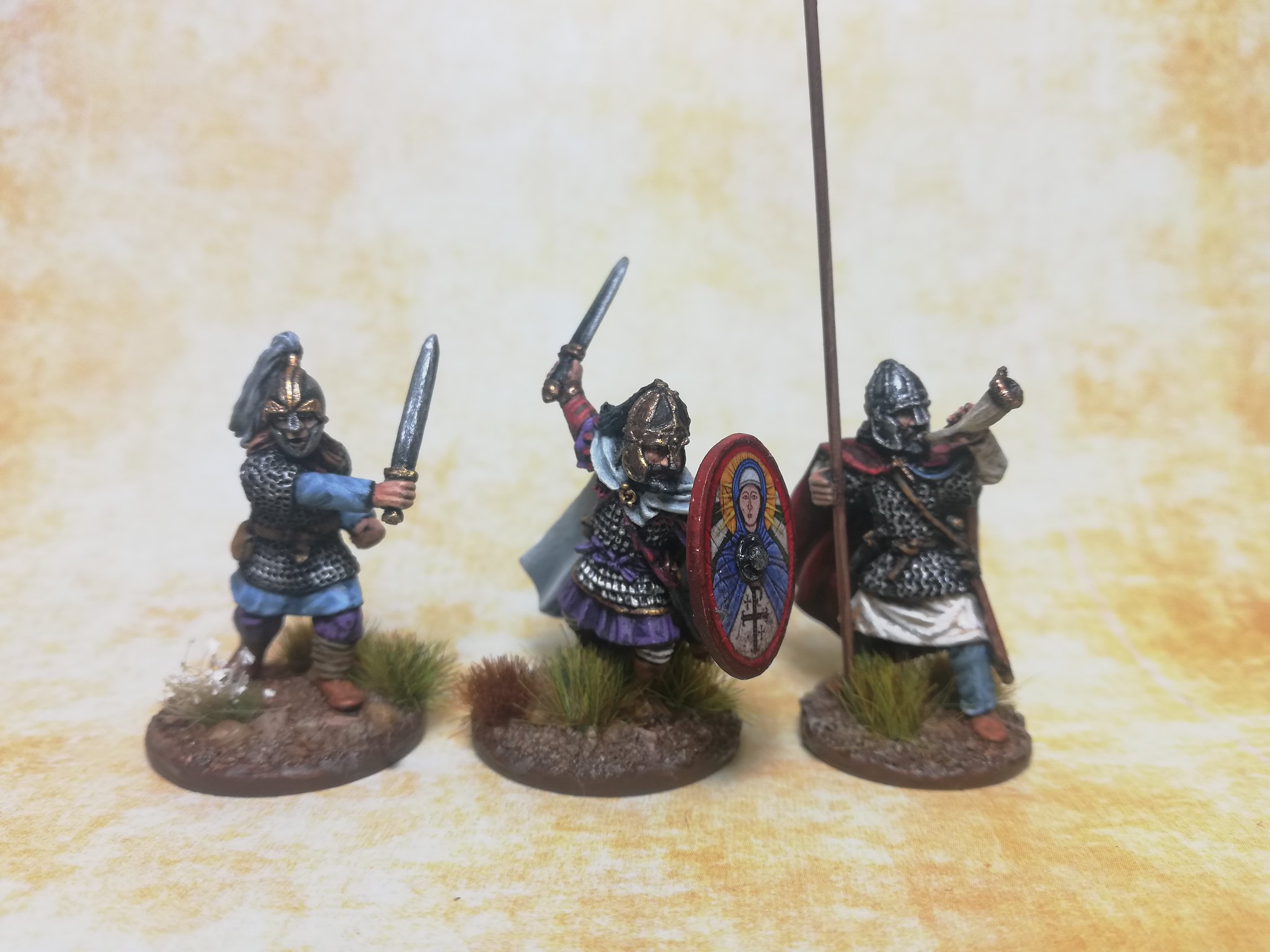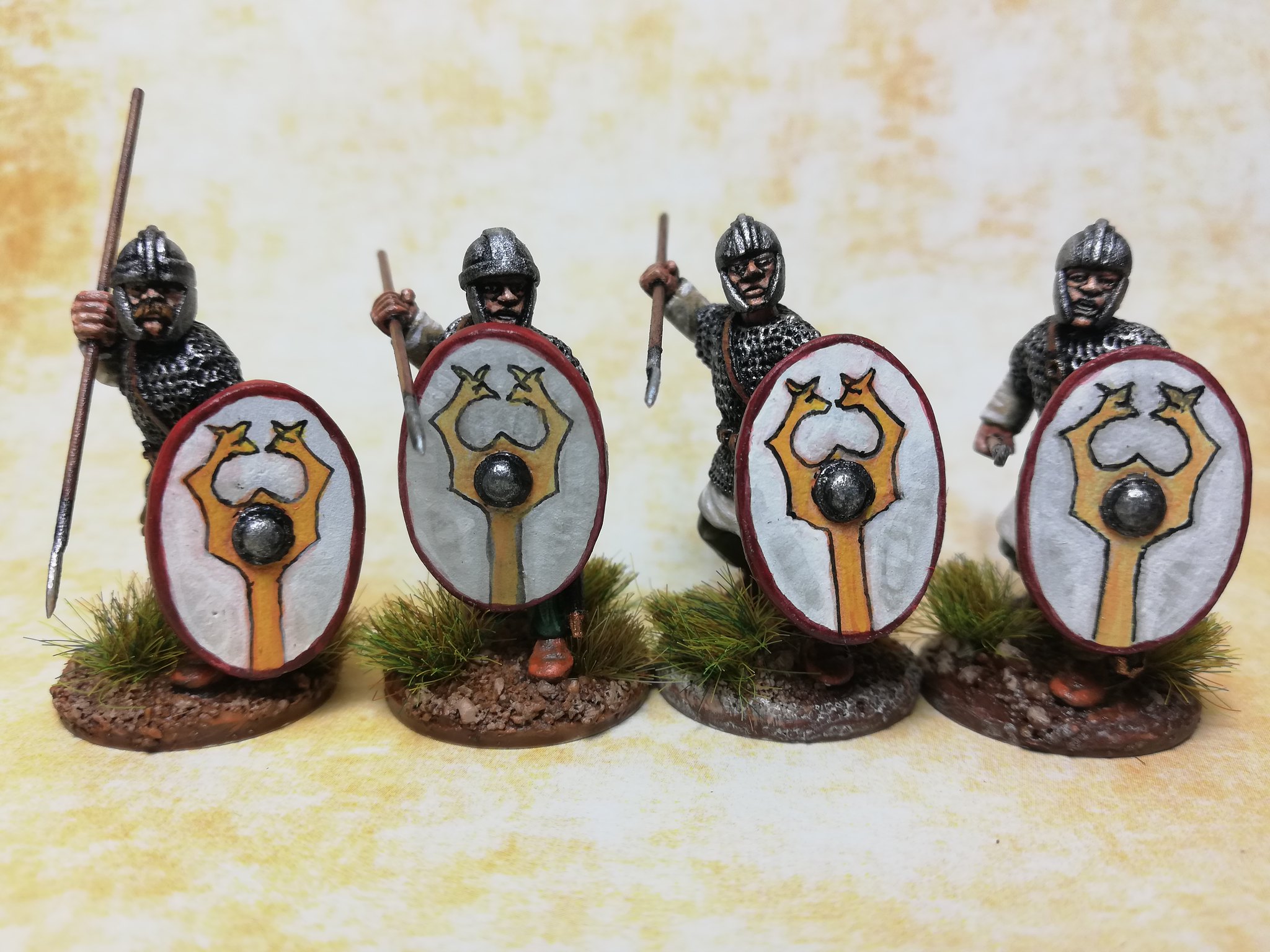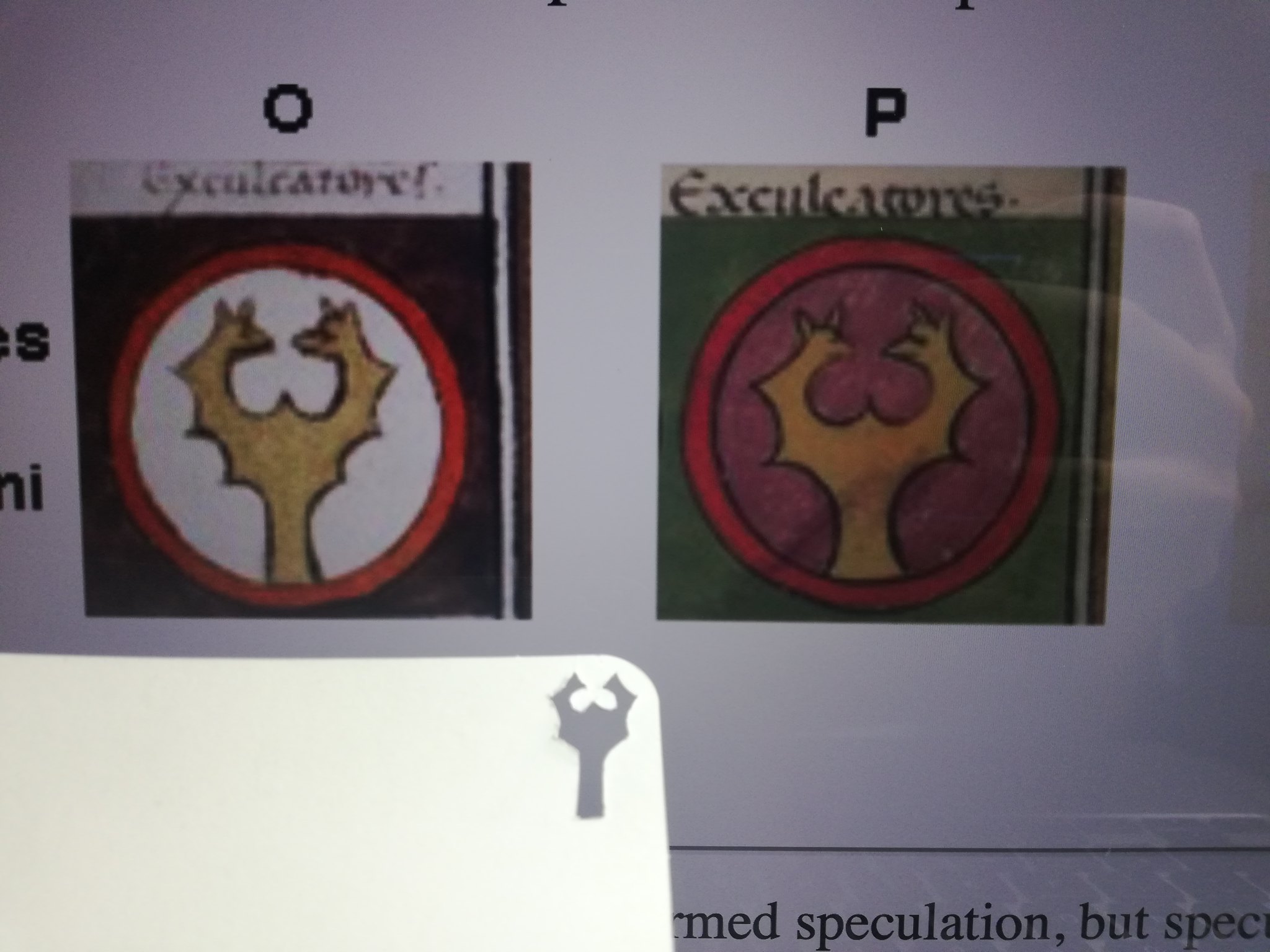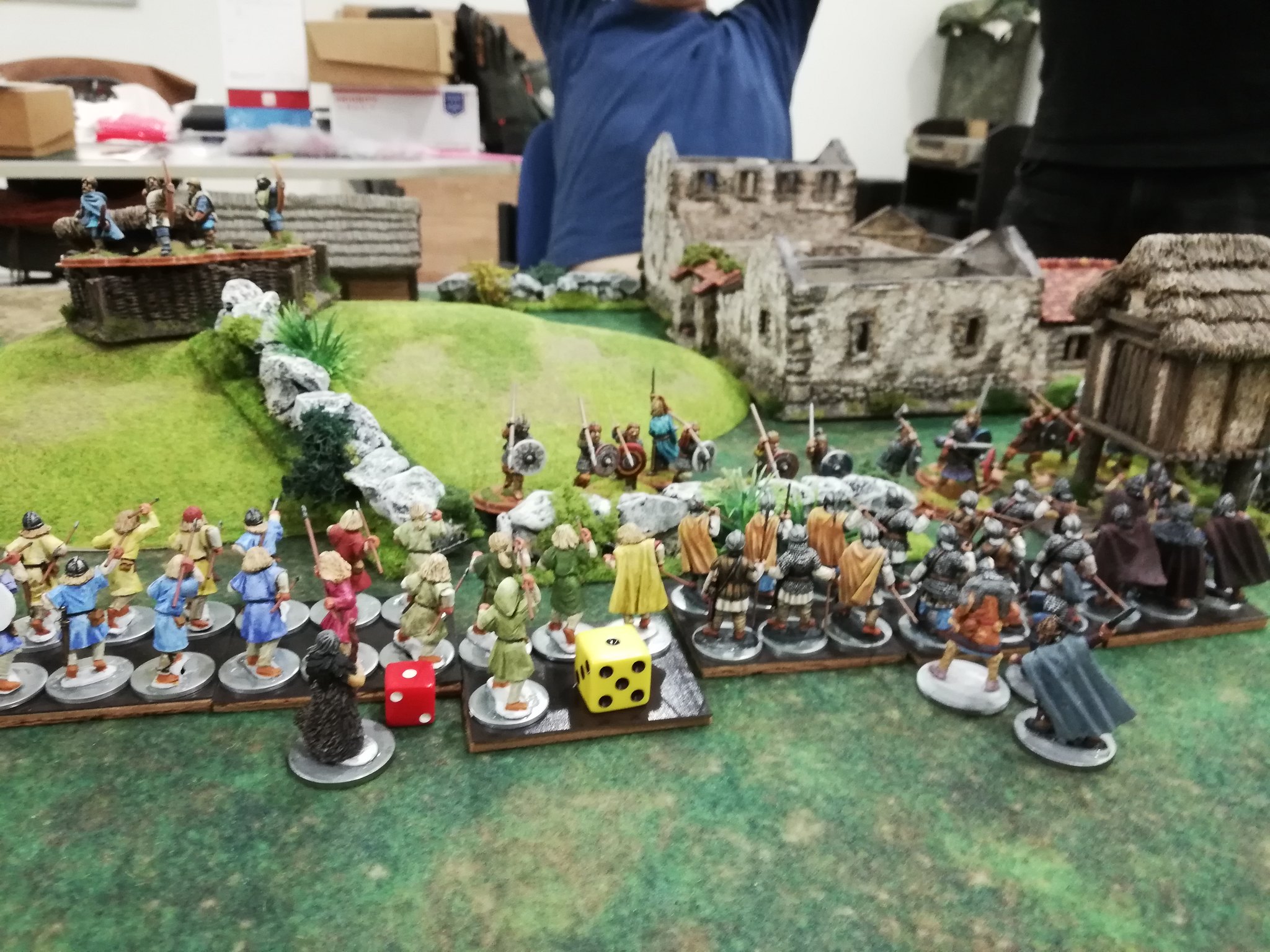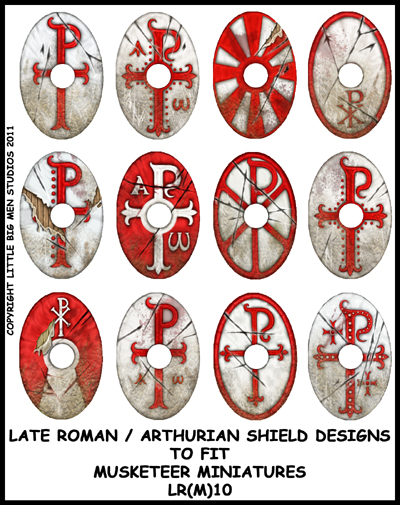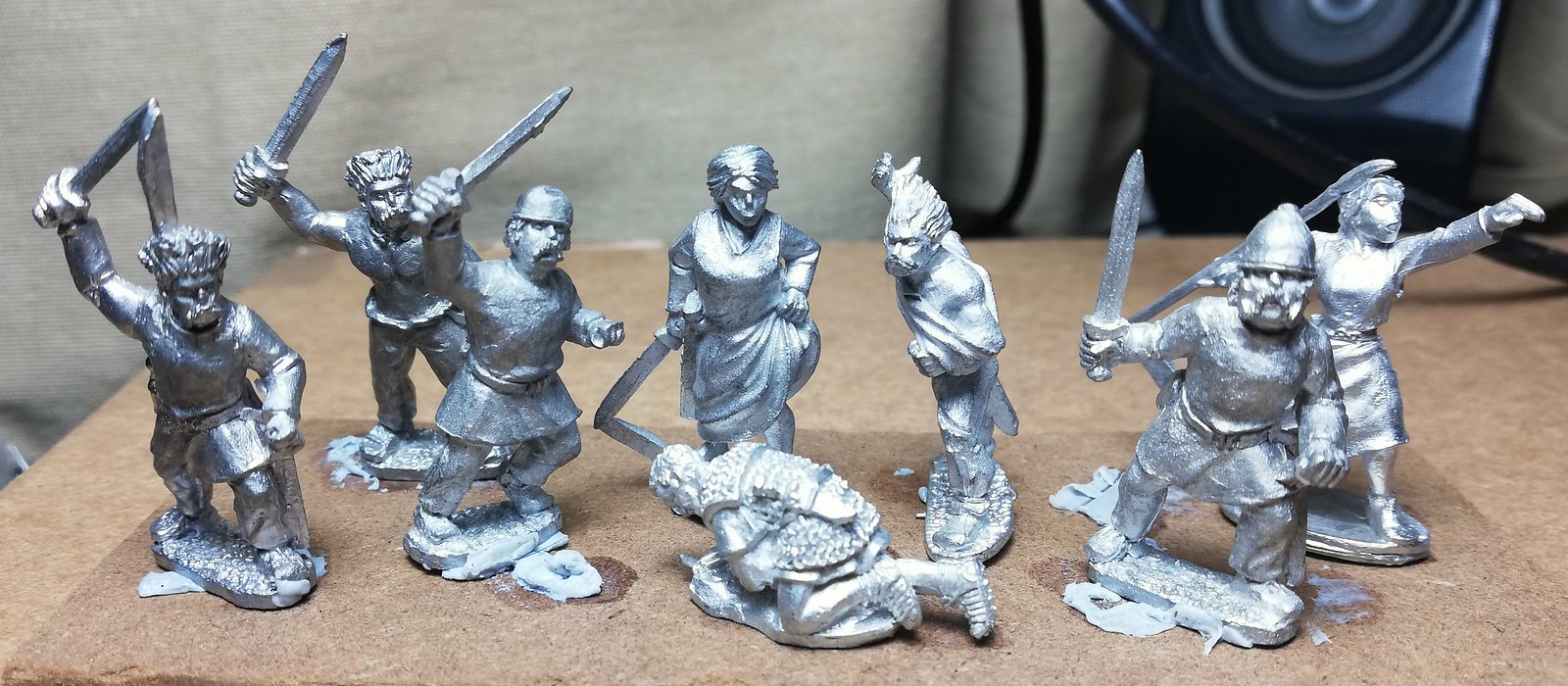Saturday, 20 April 2019
Arthur and his Knights Assemble
Arthur and his knights rally around their banner.
After months of painting my Elites and Arthur are done. I even managed to do my first tin foil banner with a transfer from LBMS. It was well worth it, especially after stabbing myself on its spear multiple times throughout this project!
The figures are all Saxon Miniatures (now Warlord-owned), apart from Footsore's Lancelot on the far right. He's awaiting inspiration for a suitable shield design. I'd like to use a large oval shield for him but it's a tight fit compared to a medium round shield.
More pictures of the team below. The Saxon Miniatures are from the Winter King range sculpted by Colin Patten, providing lots of choices for Knights of the Round Table. I like their poses and kit. My only complaint would be about the casting quality of their faces. The detail isn't as crisp as Footsore's faces. However, I'm very happy with their Arthur as Footsore lacks a suitably heroic Arthur on foot.
Being influenced by the Bernard Cornwell books I was all set to make my Arthur pagan. But a desire to wrap up this lot (batch painted in a group of 21 minis) led me to use a transfer from LBMS. I thought it'd be a nice tribute to Geoffrey of Monmouth's description of Arthur's shield bearing the Virgin Mary. He still bears the white cloak from Cornwell, though I couldn't settle on a better colour than black for his helmet plume. I'm open to suggestions (I did consider ochre).
I painted this group in common colours, mainly red, white and blue, varying the location to give them both uniformity and individuality. The white and blues would tie them together with the previously painted Warriors, whilst the red - especially the cloaks - would set them apart.
Arthur and Lancelet, being Lords, had purple mixed into their scheme and used grey-white rather than canvas white for elements of their costume.
I also finished up my archers. I may add patches later or leave them as poor, unadorned British archers.
Next steps are to finish painting my Merlin and champion, which had a different colour scheme to the rest. Though currently, I'm completing a manuballista and its crew, plus four more hand-painted shields to make this bunch SAGA-ready.
Saturday, 9 March 2019
Exculcatores Iuniores Britanniciani - COMPLETE
After a month long painting rut I am happy to report a burst of activity that culminated in the completion of two units of Warriors for my Dux Brit Late Romans, my first fully finished figures for this project. I even gave them my first freehand shields, and what an enjoyable process that was.
Here are the desperate dozen ready to face the long war of attrition with the invading Saxons.
For future reference, here are the colours I used, mostly Foundry and a few Vallejo:
THE SHIELDS
The shield designs are derived from the Notitia Dignitatum which lists the Exculcatores iuniores Britanniciani, though not specifically as a unit within the Comes Britanniae. I can't understate the value of Luke Ueda-Sarsson's site on the Notitia.
However, this particular shield design met my desire to have an historically plausible motif that featured white and red, reflecting what I understand were the common colours of that period. Epics such as Y Goddodin mention white shields. The WAB supplement Age of Arthur recommended red and white themes.
I nearly went the route of using LBMS transfers, but I wasn't keen on the red and white Chi-Ro designs on offer. After reading Bernard Cornwell's Warlord Trilogy I was keen on a less obviously Christian theme, though I won't exclude it entirely in the final force.
As it turned out I really enjoyed painting the design myself. Since the designs in the Notitia are depicted for round shields I had to adapt it somewhat for an oval shield.
The advantage of commercial shield transfers is uniformity, so I attempted to compensate by making a stencil from thin card. I should note here that there is speculation that the actual design may have been yellow and purple with a red border, but the Oxford version of the Notitia renders it as yellow and white with a red border. That suits me fine so I went with it.
I used the stencil to mark out the outline of the twin-headed zoomorphic creature with a micro-pen. I then blocked this in with Foundry Ochre Yellow for a warm yellow that would complement the cloaks on some of the figures that were also painted in the same colour.
I skipped a three-tone painting approach and just went for two tones. Since yellows are pigment weak I found it more effective to basecoat in yellow and wash selectively with the orangey shade tone to suggest texture and depth. For the white surrounding I based with Foundry Arctic Grey shade then outlined it with pure white.
The shield rears are wood and were painted up in a three tone style with Vallejo analogues to Foundry Spearshaft with a wash of Vallejo German Camo Black Brown after the basecoat. I was more sparing with the highlights towards the bottom of the shield.
The red edging was done with Vallejo Black Red followed by Foundry Bright Red shade with less of the brighter tone applied towards the bottom. The nail holes in the leather were picked out with my homemade black wash based off Les's Washes. The central grip was my usual steel mix.
Mounting the shields on double-sided tape on top of card made them very easy to handle and paint the designs. However, once the time came to paint the rears it became rather fiddly because the handling and accidental scraping led to the paint on the front coming off or adhering to the card.
So I had to work quickly and carefully and I chose to varnish them with gloss then matte as quickly as I could. I may return at a later date to add more highlights on the rim but they look pretty good as is.
In truth, I was too impatient to glue them to the figures and finish off the bases with tufts and declare these two units of six done.
I'm pretty happy with them though I feel the black edging of the central design could be softer as it seems too harsh to my eyes, but it does match the design in the Oxford Notitia.
For my future batch of Late Romans I'll probably use the red and white emblem of the Cornuti since I already have the transfers and it thematically echoes the design of the Exculcatores.
Side note: The Exculcatores were probably light infantry scouts according to this, but I'm using them on heavy infantry. The specific colour combination trumps history here.
I have to say that despite the time invested in hand painting the shields it was so much more satisfying and enjoyable than applying transfers. And fun is what this hobby is about. I wonder what my next freehand shields will be.
Here are the desperate dozen ready to face the long war of attrition with the invading Saxons.
For future reference, here are the colours I used, mostly Foundry and a few Vallejo:
British Warriors (Footsore Late Romans)
Armour & Weapons - Gunmetal Grey, Oily Steel, Silver
Hair - Black
Moustache & Beard - Deep Brown Leather
Belt and Pouches - Deep Brown Leather, Quagmire
Scabbards & Straps - Wine Stain Red, Black / Deep Brown Leather, Chestnut
Scabbard Tips & Sword Hilt/Butt + Buckles - Bronze
Shoes - Tan
Trousers - Union Trouser Blue / Moss Green / Forest Green
Puttees - Buff Leather
Flesh - Foundry Flesh Triad
Tunics - Canvas with Bright Red stripe or Border and circles
Neckerchief - Bright Red
Cloaks - Ochre
Spears - Spearshaft
Leather Armour - Deep Brown Leather
The shield designs are derived from the Notitia Dignitatum which lists the Exculcatores iuniores Britanniciani, though not specifically as a unit within the Comes Britanniae. I can't understate the value of Luke Ueda-Sarsson's site on the Notitia.
However, this particular shield design met my desire to have an historically plausible motif that featured white and red, reflecting what I understand were the common colours of that period. Epics such as Y Goddodin mention white shields. The WAB supplement Age of Arthur recommended red and white themes.
I nearly went the route of using LBMS transfers, but I wasn't keen on the red and white Chi-Ro designs on offer. After reading Bernard Cornwell's Warlord Trilogy I was keen on a less obviously Christian theme, though I won't exclude it entirely in the final force.
As it turned out I really enjoyed painting the design myself. Since the designs in the Notitia are depicted for round shields I had to adapt it somewhat for an oval shield.
The advantage of commercial shield transfers is uniformity, so I attempted to compensate by making a stencil from thin card. I should note here that there is speculation that the actual design may have been yellow and purple with a red border, but the Oxford version of the Notitia renders it as yellow and white with a red border. That suits me fine so I went with it.
I used the stencil to mark out the outline of the twin-headed zoomorphic creature with a micro-pen. I then blocked this in with Foundry Ochre Yellow for a warm yellow that would complement the cloaks on some of the figures that were also painted in the same colour.
I skipped a three-tone painting approach and just went for two tones. Since yellows are pigment weak I found it more effective to basecoat in yellow and wash selectively with the orangey shade tone to suggest texture and depth. For the white surrounding I based with Foundry Arctic Grey shade then outlined it with pure white.
The result was okay, but I decided to add more interest by painting white radiating marks around the yellow design to make it pop out more.
The shield rears are wood and were painted up in a three tone style with Vallejo analogues to Foundry Spearshaft with a wash of Vallejo German Camo Black Brown after the basecoat. I was more sparing with the highlights towards the bottom of the shield.
The red edging was done with Vallejo Black Red followed by Foundry Bright Red shade with less of the brighter tone applied towards the bottom. The nail holes in the leather were picked out with my homemade black wash based off Les's Washes. The central grip was my usual steel mix.
Mounting the shields on double-sided tape on top of card made them very easy to handle and paint the designs. However, once the time came to paint the rears it became rather fiddly because the handling and accidental scraping led to the paint on the front coming off or adhering to the card.
So I had to work quickly and carefully and I chose to varnish them with gloss then matte as quickly as I could. I may return at a later date to add more highlights on the rim but they look pretty good as is.
In truth, I was too impatient to glue them to the figures and finish off the bases with tufts and declare these two units of six done.
I'm pretty happy with them though I feel the black edging of the central design could be softer as it seems too harsh to my eyes, but it does match the design in the Oxford Notitia.
For my future batch of Late Romans I'll probably use the red and white emblem of the Cornuti since I already have the transfers and it thematically echoes the design of the Exculcatores.
Side note: The Exculcatores were probably light infantry scouts according to this, but I'm using them on heavy infantry. The specific colour combination trumps history here.
I have to say that despite the time invested in hand painting the shields it was so much more satisfying and enjoyable than applying transfers. And fun is what this hobby is about. I wonder what my next freehand shields will be.
Monday, 4 March 2019
Dux Britanniarum - Some rules clarifications
Too Fat Lardies rules can be a little frustrating in how they organise information. I thought I'd share some rules clarifications I recently obtained via the Facebook group.
I'll update this page from time to time in order to provide a single, easy to find reference.
Latest Update: 4 March 2019
Fate Cards
A Hero of the Age - Doubles the number of dice a Noble or Champion contributes to combat but doubles the chance of being hit. Since Champions are only removed once the rest of the attached unit dies the doubled chance of a hit only applies to Nobles.
In tactical terms it makes huge sense to throw your Champion into combat whenever possible, meaning you can reserve your Nobles for command or a desperate bid to tip the scales.
Carpe Diem - Since a Carpe Diem card is suited it counts towards adding an additional 1D6 in the first round of any ensuing combat provided it is of the correct suit?
Activation
When a Noble's card is dealt he can only use his Initiative ONCE per turn to Purchase a card from the Fate Deck at the start of a turn.
Light Cavalry
a) Start out as Warriors when in close combat (p. 51).
b) It is implied (p. 33) that Light Cavalry function similar to Harassing Troops (except in close combat above), when doing so they attack as Skirmishers.
c) A Rally card can be used to remove shock from Harassing Troops and Light Cavalry which is useful since all Shock on such types can never be rallied by Nobles (p. 54).
While you can charge your Light Cavalry into close combat doing so is risky since they find it hard to shake off shock except via a Rally card.
Wednesday, 30 January 2019
Dux Britanniarum Learning Game
Over the weekend we had our first go at the Dux Brit rules. It shares the virtues and vices common with other Too Fat Lardies rules. The overall system is intuitive and models a good feel for the period.
However, the rules suffer from poor organisation, it's a nightmare finding things during the thick of battle. Important information is buried in wordy paragraphs when a simple list or table would suffice for easy reference and there are many situations where one just has to apply common sense to address gaps in the rules. We have similar frustrations with Chain of Command but I love the depth of that ruleset.
We played a Village Raid scenario where the Saxons have to loot said village and get away with it before the British stop them. With the Saxons have a generous four turns to saunter into the village before the game started this game was shaping up to be like cops (the British) besieging a bank heist.
I brought my Romano-Brits, which I've nearly finished painting. The prospect of this game was a good impetus to at least block in the base colours on all the figures.
I knocked up some simple magnetic movement bases since I use metal washers to base my minis. I glued magnetic sheet to 6cm wide by 5cm deep MDF. It made for a tight fit. I'm considering making bigger bases to offer more to grip on but 6cm works well for Dux Bellorum and doubling up for Impetus, so I may just keep them and dress up the exposed areas with a bit of grit and flock.
The A Strong Arm card is great! Masses and masses of shock. The Saxons broke not long after.
Them breaking Saxons by the time we called an end to the game.
However, the rules suffer from poor organisation, it's a nightmare finding things during the thick of battle. Important information is buried in wordy paragraphs when a simple list or table would suffice for easy reference and there are many situations where one just has to apply common sense to address gaps in the rules. We have similar frustrations with Chain of Command but I love the depth of that ruleset.
We played a Village Raid scenario where the Saxons have to loot said village and get away with it before the British stop them. With the Saxons have a generous four turns to saunter into the village before the game started this game was shaping up to be like cops (the British) besieging a bank heist.
I brought my Romano-Brits, which I've nearly finished painting. The prospect of this game was a good impetus to at least block in the base colours on all the figures.
I knocked up some simple magnetic movement bases since I use metal washers to base my minis. I glued magnetic sheet to 6cm wide by 5cm deep MDF. It made for a tight fit. I'm considering making bigger bases to offer more to grip on but 6cm works well for Dux Bellorum and doubling up for Impetus, so I may just keep them and dress up the exposed areas with a bit of grit and flock.
The A Strong Arm card is great! Masses and masses of shock. The Saxons broke not long after.
Them breaking Saxons by the time we called an end to the game.
Wednesday, 16 January 2019
Dux Britanniarum!
Distraction strikes once again in the land of wargaming. I have been sidetracked from my ancients project with the prospect of Dark Age gaming, specifically the Arthurian age of Late Antiquity.
Since its always more rewarding to paint for a game where there are ready players I've let myself get talked into playing Romano-Britons versus an existing army of Saxons held by gamesmaster Damon using the Two Fat Lardies' Dux Britanniarum rules.
Here are the fruits of some sporadic painting over the last few months.
First up, a near complete two groups of Roman spearmen, figures by Footsore Miniatures.
Near complete as the shields and bases aren't done yet. I'm mainly undecided on the shields. For reasons I detail below.
Part of the process of psyching myself up for this project has been consuming literature related to Arthur and the Saxon conquest/migration.
One key text has been the fantastic Age of Arthur supplement for Warhammer Ancient Battles, now out of print and rather rare or exorbitantly expensive on the second hand market. Thanks to a Facebook group I was lucky enough to contact one of the authors, James Morris, and purchased a spare copy directly from him.
(James was also kind enough to dig up a spare unpainted and out of production La Dama De Elche from Gripping Beast for my Iberian project.)
The other inspiring text has been Bernard Cromwell's smashing Arthur trilogy, the Warlord Chronicles. This series presents a largely pagan or agnostic Arthur, although in all probability whoever may have been the historical Arthur would likely have been Christian whether he was Roman or Briton.
Still, I rather fancy a pagan Arthur for my campaign, or one not so obviously Christian. This meant scrapping my original plan for a red and white shield theme based on Little Big Man Studio's Chi-Ro transfers. In any case, the design below is somewhat speculative, not being in the Notitia Dignitatum.
After a bit of research on Luke Ueda-Sarsson's excellent site on the Notitia I thought I might adapt the design of the Exculcatores Iuniores Britanniciani, part of the Comes Britanniae. It is somewhat similar to the Cornuti design above with a twin-headed element, especially the - likely erroneous - Oxford variant on the left below.
Since no version of this design is available as a transfer I'm going to try my luck freehanding it. I can't go too wrong if I broadly follow the contours of the Cornuti design.
Since its always more rewarding to paint for a game where there are ready players I've let myself get talked into playing Romano-Britons versus an existing army of Saxons held by gamesmaster Damon using the Two Fat Lardies' Dux Britanniarum rules.
Here are the fruits of some sporadic painting over the last few months.
First up, a near complete two groups of Roman spearmen, figures by Footsore Miniatures.
Near complete as the shields and bases aren't done yet. I'm mainly undecided on the shields. For reasons I detail below.
Part of the process of psyching myself up for this project has been consuming literature related to Arthur and the Saxon conquest/migration.
One key text has been the fantastic Age of Arthur supplement for Warhammer Ancient Battles, now out of print and rather rare or exorbitantly expensive on the second hand market. Thanks to a Facebook group I was lucky enough to contact one of the authors, James Morris, and purchased a spare copy directly from him.
(James was also kind enough to dig up a spare unpainted and out of production La Dama De Elche from Gripping Beast for my Iberian project.)
The other inspiring text has been Bernard Cromwell's smashing Arthur trilogy, the Warlord Chronicles. This series presents a largely pagan or agnostic Arthur, although in all probability whoever may have been the historical Arthur would likely have been Christian whether he was Roman or Briton.
Still, I rather fancy a pagan Arthur for my campaign, or one not so obviously Christian. This meant scrapping my original plan for a red and white shield theme based on Little Big Man Studio's Chi-Ro transfers. In any case, the design below is somewhat speculative, not being in the Notitia Dignitatum.
I did purchase the decals below, but since they are for auxilia (the Cornuti) I wanted an historical scheme that could have been used in Britain in that period.
After a bit of research on Luke Ueda-Sarsson's excellent site on the Notitia I thought I might adapt the design of the Exculcatores Iuniores Britanniciani, part of the Comes Britanniae. It is somewhat similar to the Cornuti design above with a twin-headed element, especially the - likely erroneous - Oxford variant on the left below.
Since no version of this design is available as a transfer I'm going to try my luck freehanding it. I can't go too wrong if I broadly follow the contours of the Cornuti design.
Thursday, 30 August 2018
Return to the Punic Wars
It's back to ancients, my first love in historical gaming.
After a hiatus of nearly one and a half years due to work, life and the distractions of World War II gaming I am back to working on the Punic Wars (after a brief spell of GADD over mythology and vintage Citadel minis).
Settling on an optimum base size and an initial ruleset has provided a much needed spur to reduce my pile of plastic and lead of Punic Wars miniatures.
The petite army lists in Basic Impetus 2.0, of around 10 to 11 units, provided a manageable starting point to focus painting and production. So far, I have nearly finished painting four units: spearmen of the Sacred Band, Balearic slingers, Iberian scutarii and Iberian caetrati. Next up are Libyan skirmishers and Numidian light horse.
I think the toughest decision to make in ancients wargaming is neither scale nor ruleset, but rather what basing convention and approach to take.
Basing and rulesets are reflexive choices, each influencing the other. I finally decided on using Impetus basing for a number of reasons. The primary reason is aesthetic, besides the tactics and history, this hobby is about aesthetics or else wooden blocks serve just as well.
If this time-consuming hobby is about great looking miniatures then dioramas seem the way to go as opposed to single-figure basing focused on serried ranks and files of troops, or an equivalent approach via multi-basing.
Impetus basing - on 12cm wide bases in 28mm scale - lets the figures breathe and allows for greater aesthetic flexibility, especially in composition.
It also translates well to both the gaming table and the other ancients rulesets I am interested in playing. The latter all happen to be 'element' based and include Hail Caesar and To The Strongest!
12cm fits nicely in a 6' to 8'-wide table allowing a battle line of about 15 units wide, which nicely accords with my desired sweet spot of big games of 20 or so units per side (the rest being in reserves).
Once I took the leap to arranging my troops on their bases in diorama rather than in just dense ranks, there was an immediate shift in my cognitive process. I began to consider how each individual figure related to others in the group, what story they told together rather than how best to face them forward and rank them nicely.
Frankly, it became much more intellectually engaging and pleasing. It became more fun.
Casualty figures become very useful for adding character and story to a base. Here I have a draft composition of a Celtic warband. I love the way the female warrior relates to the Roman she has downed.
I've decided not to pack too many figures on my bases. Partly to save production time, partly because they actually look a bit better with some irregular space between them, and partly to ensure a bit more protective base space when clumsy fingers descend from the heavens - I've already broken one javelin multiple times.
Starting with Basic Impetus 2.0 has already paid off since I have nearly finished painting four units in just over a month. That's more than I've been able to do since acquiring this horde of lead and plastic two years ago. The size of a project for Hail Caesar or To The Strongest! was paralytically large. Too large to get off the ground.
Now that things are moving along faster than ever, being realistic, I should be able to start work on the Romans by the end of the year.
Wednesday, 29 August 2018
Paint & Switch: From Vallejo to Foundry
I really must learn to paint faster. One step towards that has been to slowly shift towards using more serviceable paints. I've found Vallejo paints to be rather uneven in quality with far too much uneven lumpiness and chalkiness. I suspect I could try diluting with matt medium instead of water to improve consistency without overdoing flow.
They served well for my World War II project which relied on a fairly simple approach, but won't hold up for the brighter, crisper look I'm aiming for with ancients. It's also taking too long to match colours as I have effectively shifted to a triad approach.
Thus, I've slowly made the shift to using Wargames Foundry paints after very pleasant experiences with their flesh triads. The Sacred Band below were painted using Foundry's Mediterranean Flesh triad and its very subtle.
The Foundry paint had a good consistency out of the bottle, required very little thinning, and applied very evenly to surfaces. The three tones also worked harmoniously creating a surprisingly realistic impression even at close distance. Sometimes I had cause to deepen the shade with a wash, but it mostly applied fine.
I found it was particularly effective to apply the flesh tone shade in a light coat over a white primer as this created a natural highlight on the raised areas which provided clear guidance on where to apply subsequent lighter tones.
The spearshafts above were haphazardly painted with whatever earth and wood tones I could muster amongst my existing Vallejo paints but I'm not satisfied. The Flat Earth basecoat was far too red. Now I have the Foundry Spearshaft spears and javelins should be a doddle. A good thing to as there will be many to paint.
I painted the linothoraxes above with a Vallejo stone grey basecoat, a homemade wash, followed by a highlight with a frustratingly chalky Vallejo ivory. The ivory was coming thick as toothpaste out of the bottle. Since dilution with water was leading to chalkiness - the titanium oxide in white paints is quite coarse - I tried diluting with matt medium which led to better results.
With Carthaginian and Greek projects lined up there will be many many linothoraxes to paint, so switching to the Foundry Canvas triad should speed up the work. For my next lot of Libyan spearmen I've a mind to employ more Hellenistic colours such as madder and blue for the linothoraxes to create some variety and visual interest.
I've yet to identify a suitable blue triad out of Foundry's selection for this purpose. Possibly their Vivid Blue. The only drawback with ordering Foundry paints is that all one has to go on are the names (which are at least usually indicative) and website colours (which will vary with one's monitor).
Subscribe to:
Posts (Atom)
